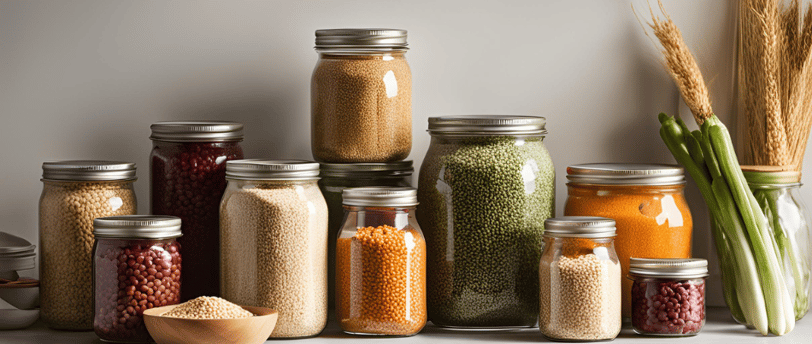10 Budget-Friendly Ingredient Swaps to Help You Save Big on Groceries
When you’re feeding a family on a budget, every little bit counts. One of the easiest ways to cut grocery costs is to make a few simple swaps in your favorite recipes. By using affordable alternatives, you can enjoy the same delicious meals while keeping your budget in check. Here are 10 budget-friendly ingredient swaps that make it easier to stretch your dollar without sacrificing flavor or nutrition.
HELPFUL TIPS
11/7/20245 min read


Understanding the Importance of Ingredient Swaps
Ingredient swaps play a crucial role in managing a budget while maintaining culinary creativity. By replacing expensive or hard-to-find items with more affordable alternatives, you can significantly reduce your grocery costs over time. For instance, substituting fresh herbs with dried ones or using canned vegetables instead of fresh can produce considerable savings without compromising the flavor or nutritional value of your meals. This flexibility allows you to explore new cooking methods and flavors while adhering to financial constraints.
Additionally, ingredient swaps can accommodate various dietary restrictions and personal preferences, making meal preparation more inclusive. For individuals with allergies or sensitivities, substituting certain ingredients ensures that everyone at the table can enjoy the meal. For example, using gluten-free flour as an alternative to regular flour or plant-based milk in place of dairy can support both health needs and taste preferences. Such adaptations enable you to create an array of dishes that cater to diverse lifestyles while promoting a wholesome approach to nutrition.
Seasonal availability is another factor to consider when discussing ingredient swaps. Purchasing ingredients that are in season not only helps to keep costs down but also enhances the freshness and taste of your meals. For instance, using frozen vegetables during off-seasons can be a smart choice, preserving their nutrients and reducing the need to buy costly out-of-season produce. By embracing seasonal changes and making thoughtful ingredient substitutions, you ensure that your meals remain vibrant and engaging throughout the year.
Ultimately, leveraging ingredient swaps can encourage resourcefulness in the kitchen while leading to substantial cost savings. As you become accustomed to making minor adjustments in your recipes, you will discover a renewed confidence in your culinary skills, enabling you to create delicious, nutritious meals tailored to your financial and dietary needs without sacrificing quality.
Top 10 Budget-Friendly Ingredient Swaps
In the pursuit of a healthy diet without breaking the bank, consider these ten budget-friendly ingredient swaps that can significantly reduce your grocery expenses while still providing nutritional benefits and versatility in your cooking.
1. Quinoa for Brown Rice: Quinoa is often touted for its high protein content, but brown rice is a more economical alternative that still offers fiber and essential nutrients. Use brown rice in stir-fries or as a base for grain bowls to save money while maintaining a nutritious meal.
2. Canned Beans Instead of Meat: Canned beans are not only budget-friendly but also rich in protein and fiber. Replacing meat with beans in chili or soups not only cuts costs but also allows for greater versatility and vegetarian meal options.
3. Frozen Vegetables Over Fresh: While fresh vegetables can be costly, frozen varieties often come at a lower price and retain their nutritional value. Incorporate frozen vegetables in casseroles or stir-fries to add bulk and nutrients without the premium price tag.
4. Greek Yogurt for Sour Cream: Opting for Greek yogurt instead of sour cream provides a similar creamy texture with added protein and less fat. It works wonderfully as a topping for baked potatoes or as a base for dips.
5. Oats Instead of Breakfast Cereal: Swapping out sugary cereals for whole oats is a budget-wise choice that increases fiber intake. Rolled or steel-cut oats can be cooked with water or milk to create a filling breakfast, topped with fruits or nuts.
6. Vegetable Broth for Stock: Instead of purchasing expensive stock, use vegetable broth, which can enhance flavor in soups and rice dishes without the higher price tag. Making your own broth from vegetable scraps can also save you money.
7. Almonds for Pine Nuts: Pine nuts tend to be pricey, but roasted almonds can be used in pestos or as a salad topping for significantly less cost while providing similar health benefits and flavor.
8. Apple Sauce for Oil in Baking: Substituting apple sauce for oil in baking recipes reduces fat content and adds moisture. Use it in muffins or cakes to create a healthier yet delightful treat.
9. Whole Wheat Pasta Instead of Regular Pasta: Whole wheat pasta offers more fiber and nutrients and is often available at a similar price as its regular counterpart. It can easily be swapped in any pasta dish for a healthier meal.
10. Homemade Salad Dressing Over Bottled: Pre-packaged dressings can be costly and often contain unhealthy ingredients. Making your own dressing with olive oil, vinegar, and spices not only saves money but allows for custom flavors that suit your palate.
In conclusion, with these budget-friendly ingredient swaps, individuals and families can significantly save on their grocery bills without sacrificing nutrition or taste. Integrating these alternatives into your meal planning and everyday cooking can lead to healthier eating habits and financial savings over time.
Creative Ways to Incorporate Ingredient Swaps into Your Meals
Incorporating budget-friendly ingredient swaps into your meals can be both enjoyable and rewarding. By embracing these substitutions, you can maintain the taste and nutritional value of your dishes while saving money on groceries. Here are some innovative suggestions to help you seamlessly integrate these swaps into your cooking routines.
Start by reimagining familiar recipes with more affordable alternatives. For instance, if a recipe calls for chicken breast, consider using canned beans or lentils as a protein source in salads and stir-fries. This not only caters to a tighter budget but also adds a rich texture and flavor to your meals. Similarly, substitute white rice with quinoa or cauliflower rice for a nutritious twist, particularly beneficial for those pursuing a low-carb lifestyle.
Another effective strategy is to modify sauces and dressings through ingredient swaps. If a recipe requires heavy cream, try using Greek yogurt or silken tofu to create creamy sauces that are lower in calories. These alternatives work well in pasta dishes, soups, and dips, ensuring that you do not compromise on flavor. For salad dressings, olive oil can be an expensive ingredient; using a mix of vinegar and a small amount of mustard offers a tasty, cost-effective solution.
When it comes to baking, explore how to swap out flour types or sweeteners. Whole wheat flour can often replace all-purpose flour, providing additional fiber and nutrients, while using mashed bananas or applesauce can serve as healthier, natural sweeteners instead of sugar or butter in many recipes. These adjustments can enhance the nutritional profile without sacrificing the beloved taste of your baked goods.
Lastly, embrace the versatility of seasonal vegetables. Combining different seasonal produce, which tends to be more budget-friendly, can elevate your dishes while fostering variety within your meals. Experimentation with ingredient swaps can invigorate your cooking, making healthy eating an achievable goal without financial strain.
Weekly Budget Swap Challenge:
Challenge yourself to save money and explore new culinary ideas by making one ingredient swap each week. Select an ingredient you regularly use in your meals and research budget-friendly alternatives that maintain flavor and nutritional value. For example, swap fresh herbs for dried ones, or replace meat with beans in soups and casseroles.
This simple challenge helps you gradually reduce grocery costs while discovering creative substitutions that enhance your meals. By focusing on one swap at a time, you’ll find it easier to experiment with new flavors and cooking techniques, making the process enjoyable and manageable.
The benefits of this challenge go beyond saving money. It encourages resourcefulness and fosters a deeper understanding of how simple changes can lead to healthier and more affordable meals. Over time, these small adjustments add up, allowing you to stick to your budget without sacrificing the quality or variety of your dishes.
By embracing this weekly swap challenge, you can cultivate better cooking habits, improve your budget management skills, and expand your repertoire of budget-friendly recipes. It’s a practical and rewarding way to approach grocery savings and meal preparation.


Easy Healthy Recipes for Busy Cooks
Connect
© 2025 All rights reserved.


